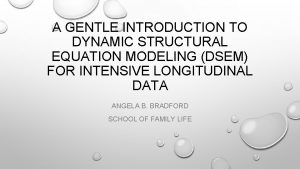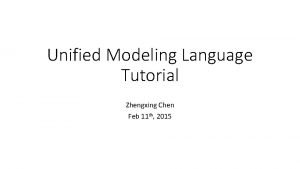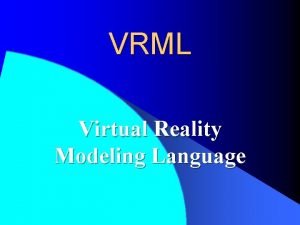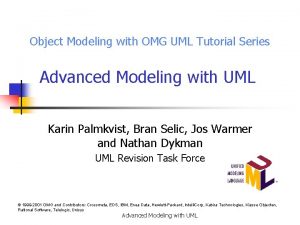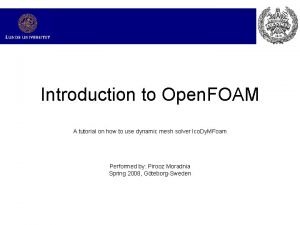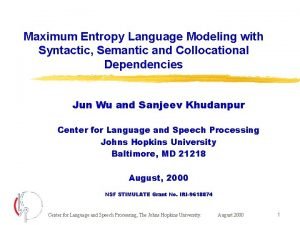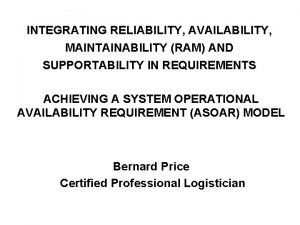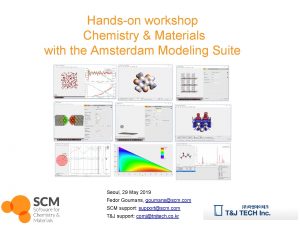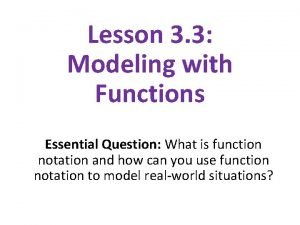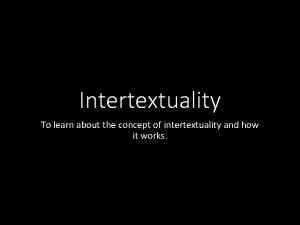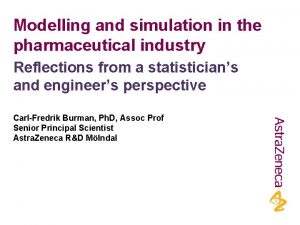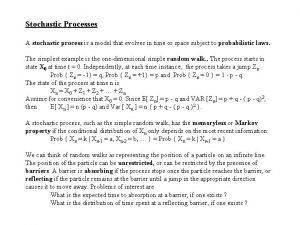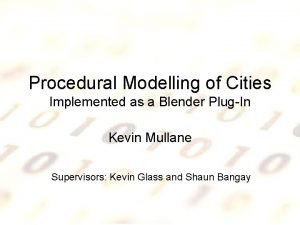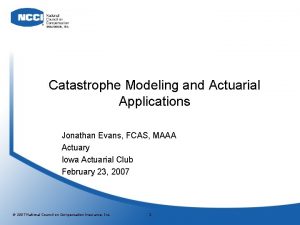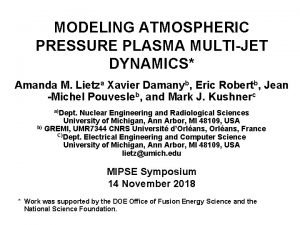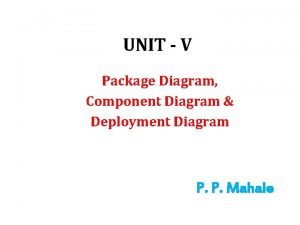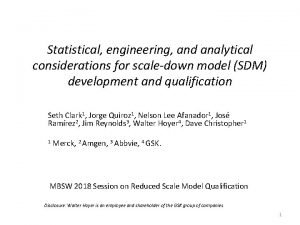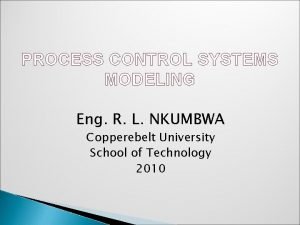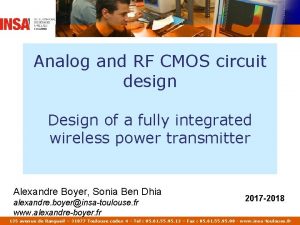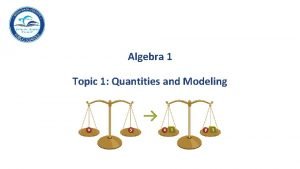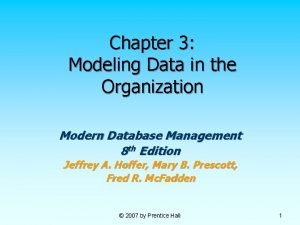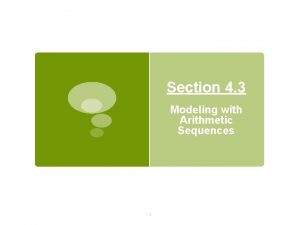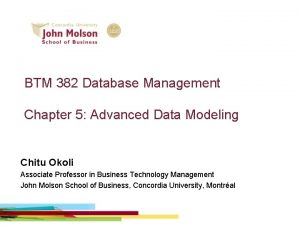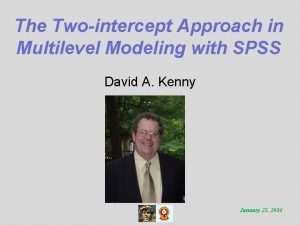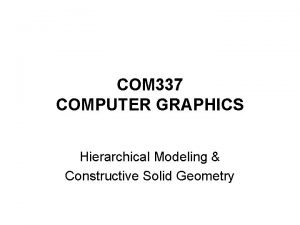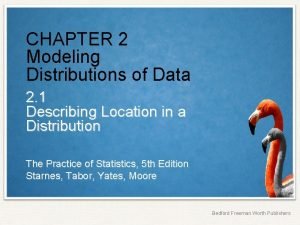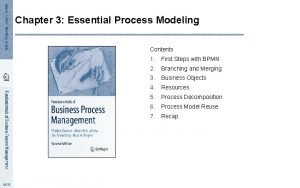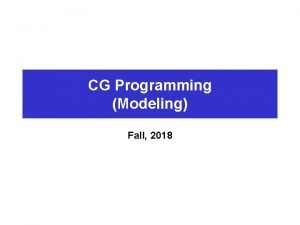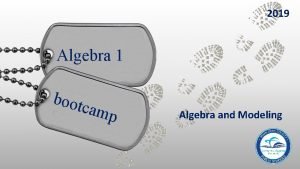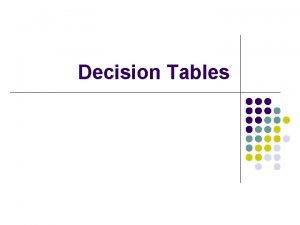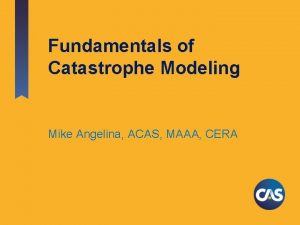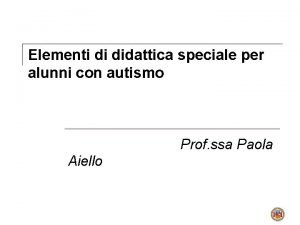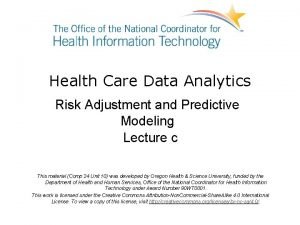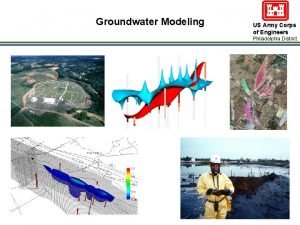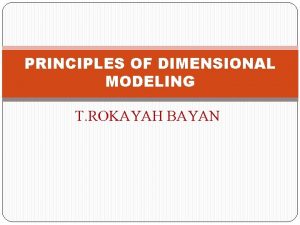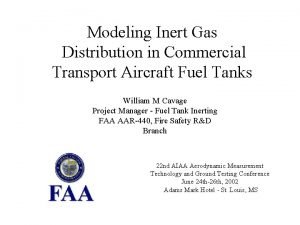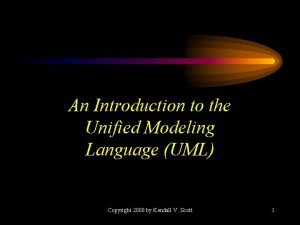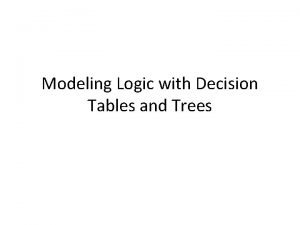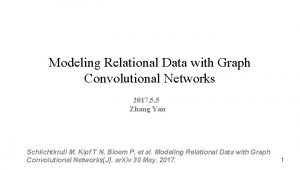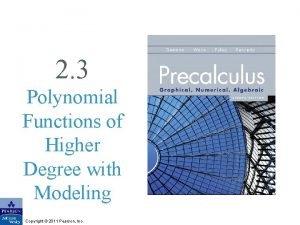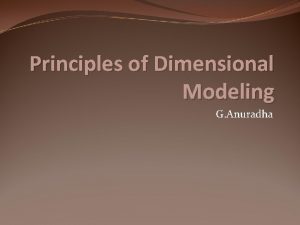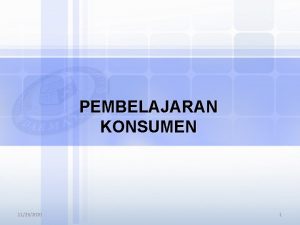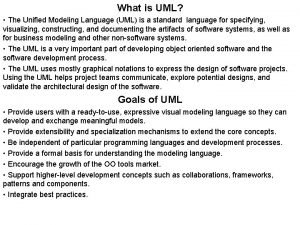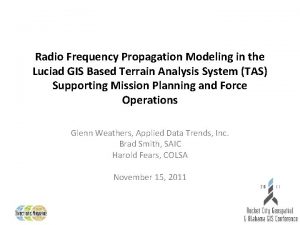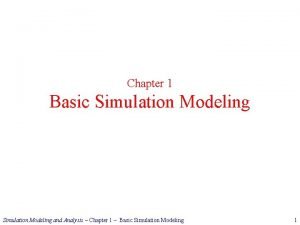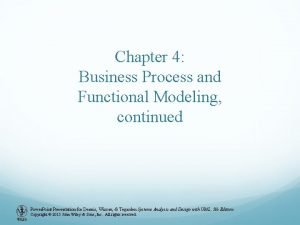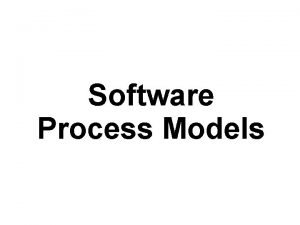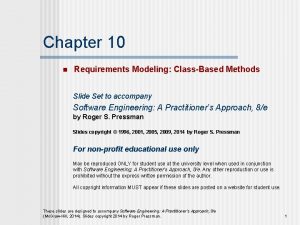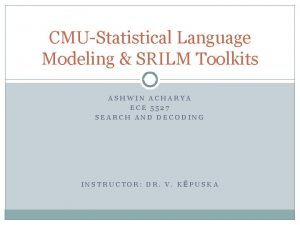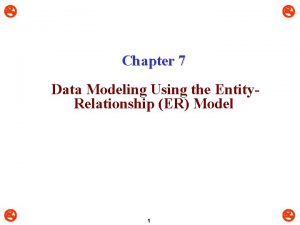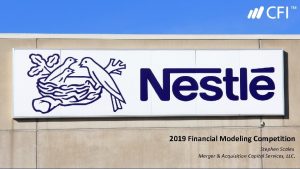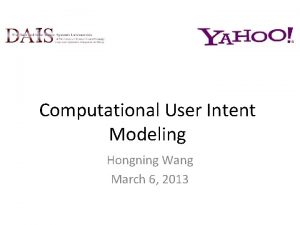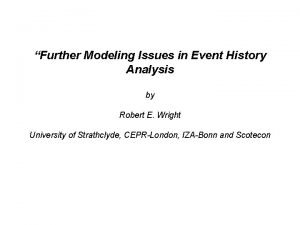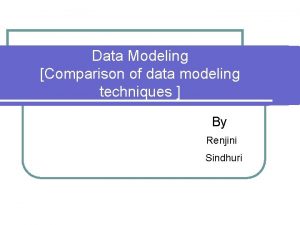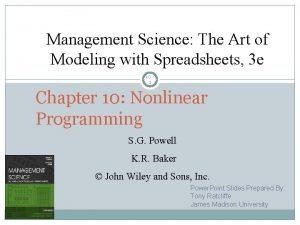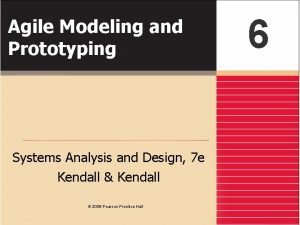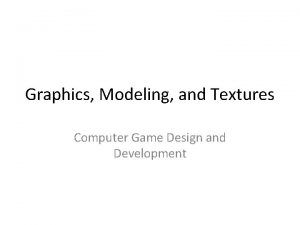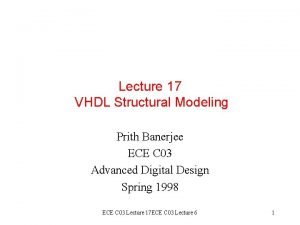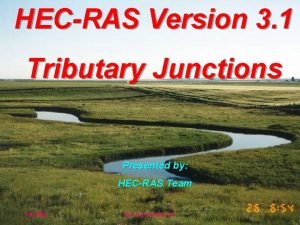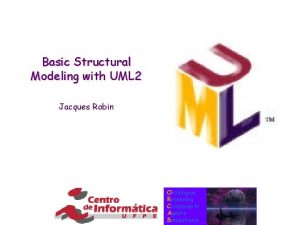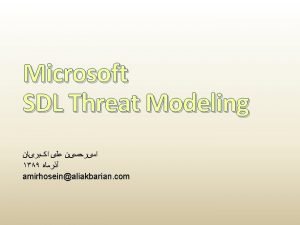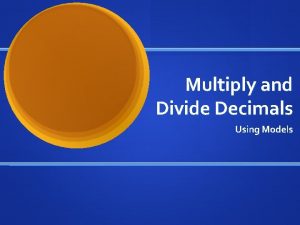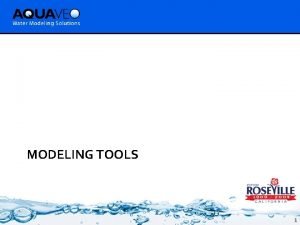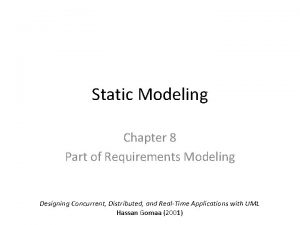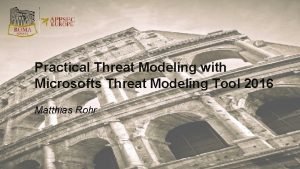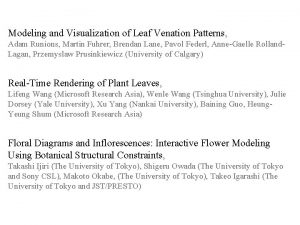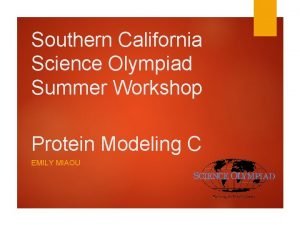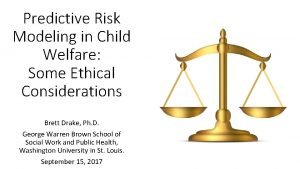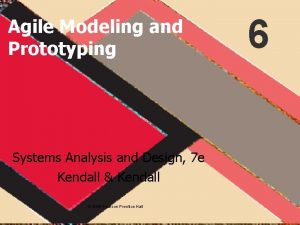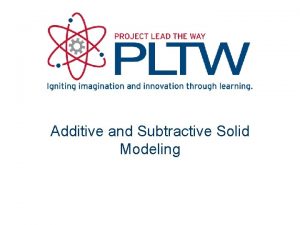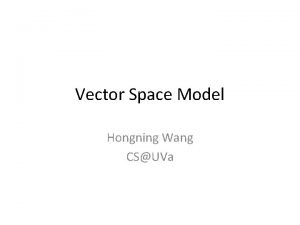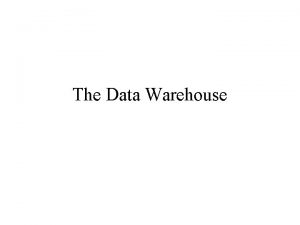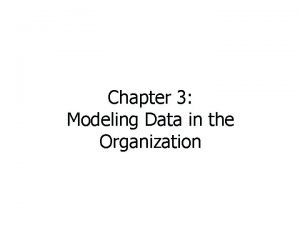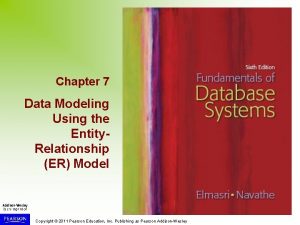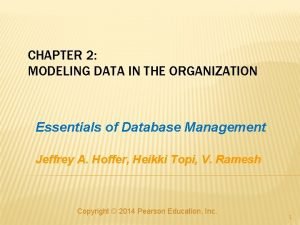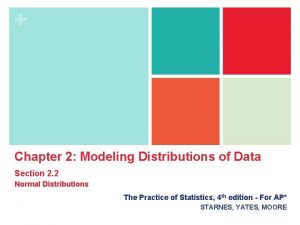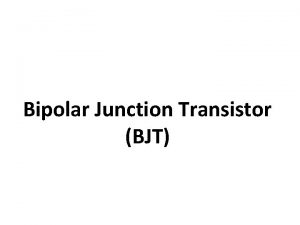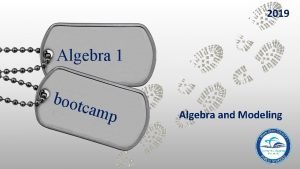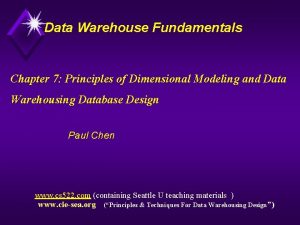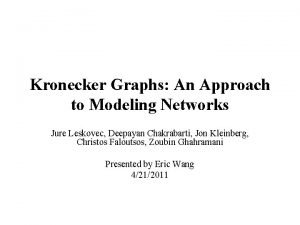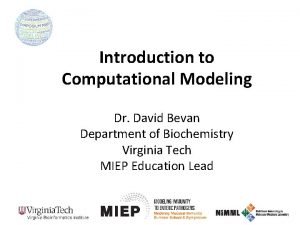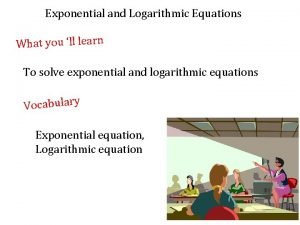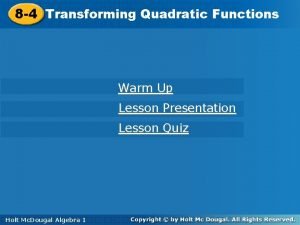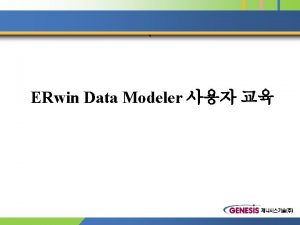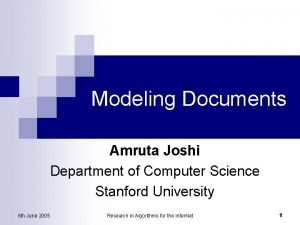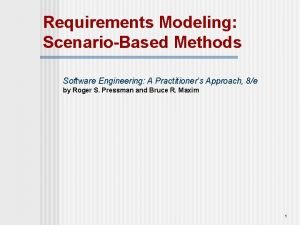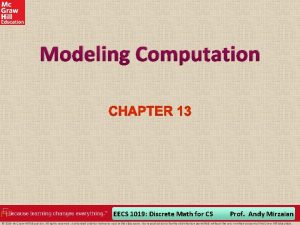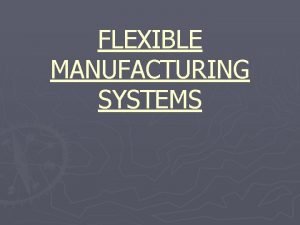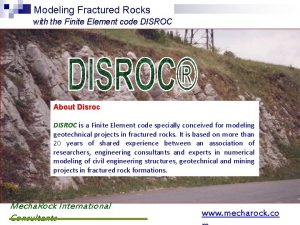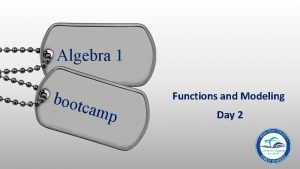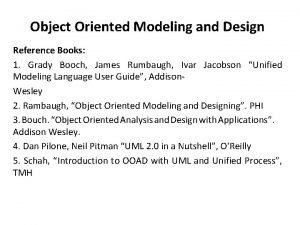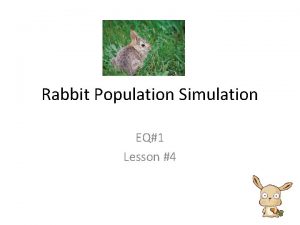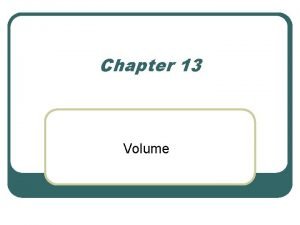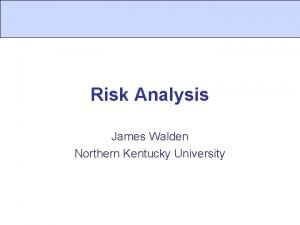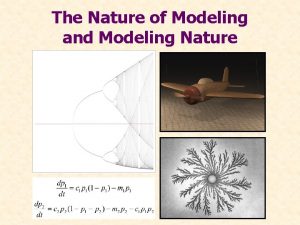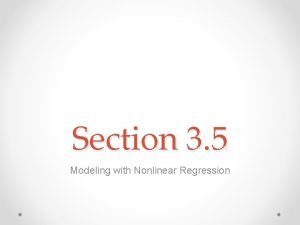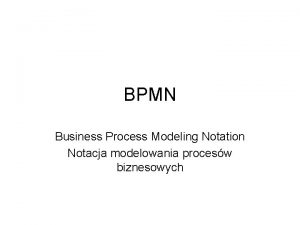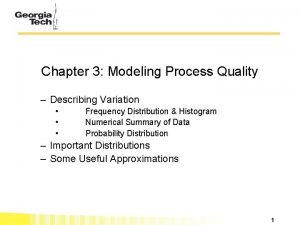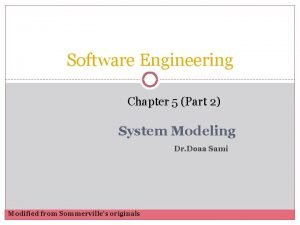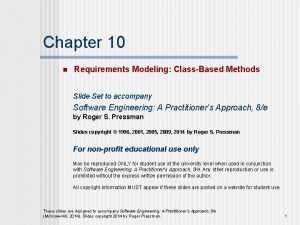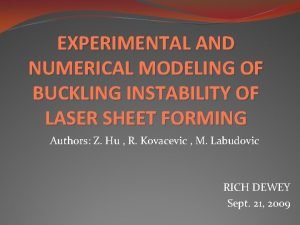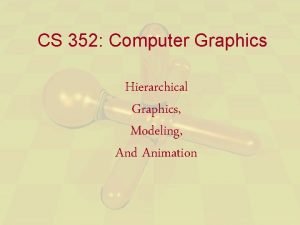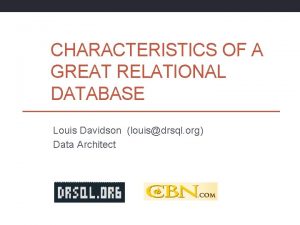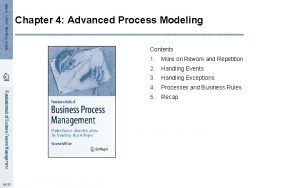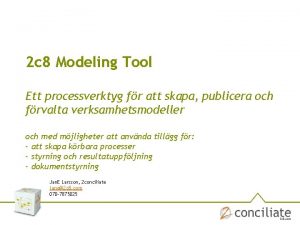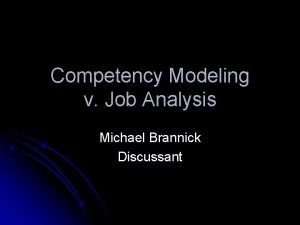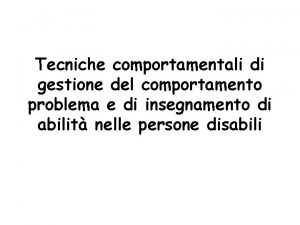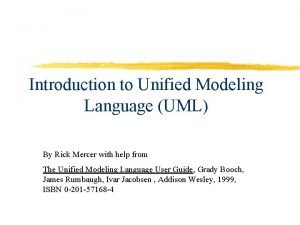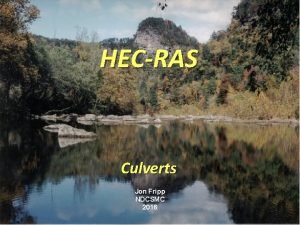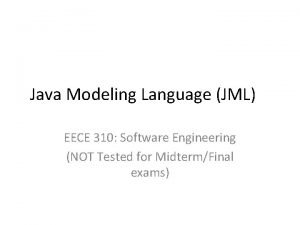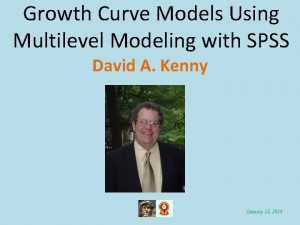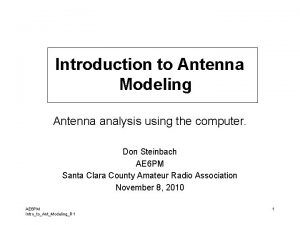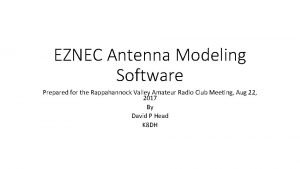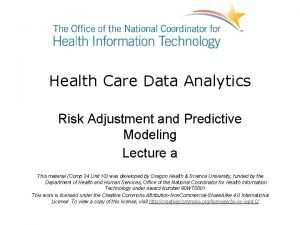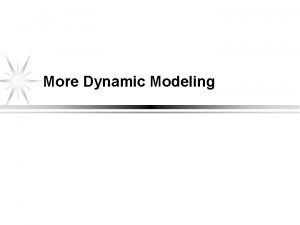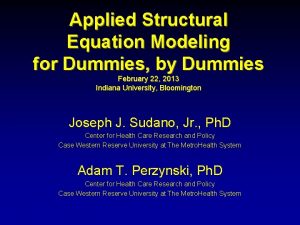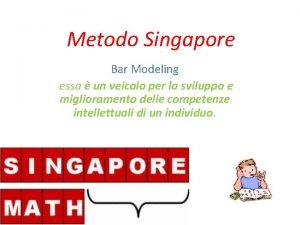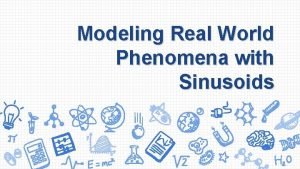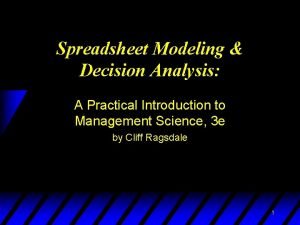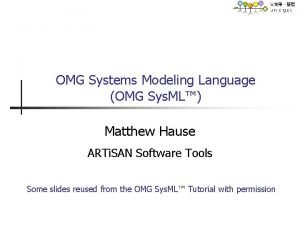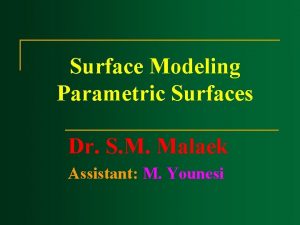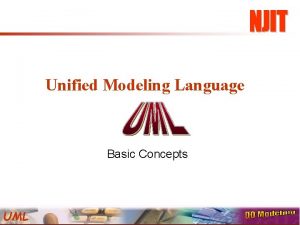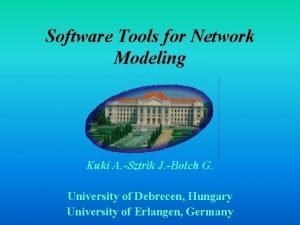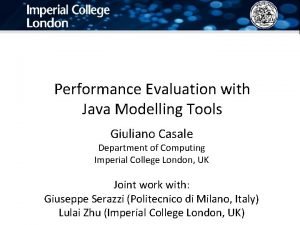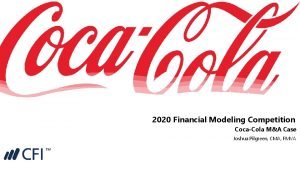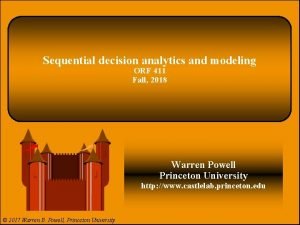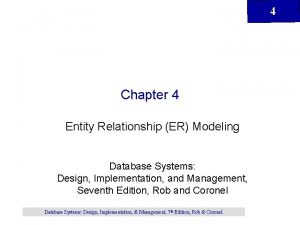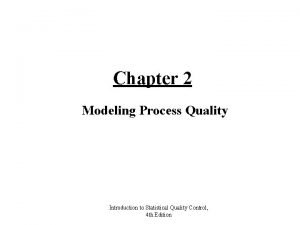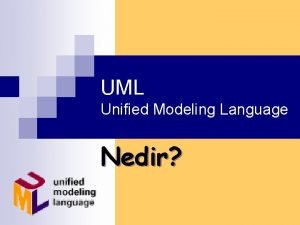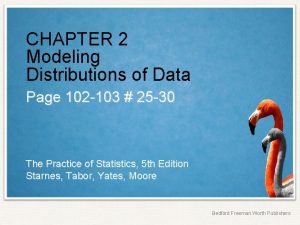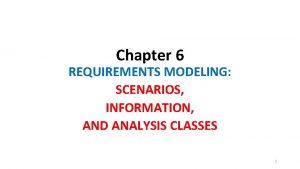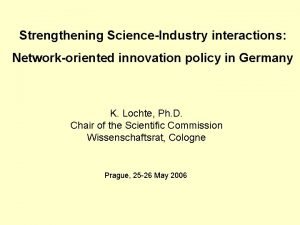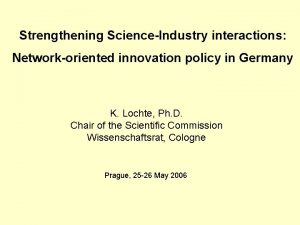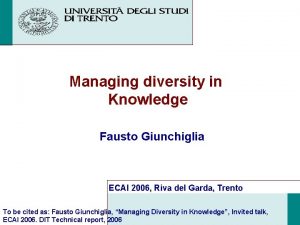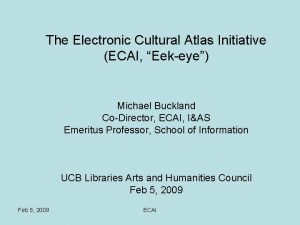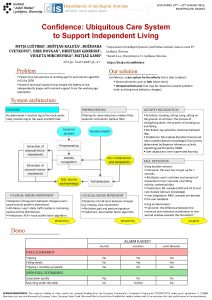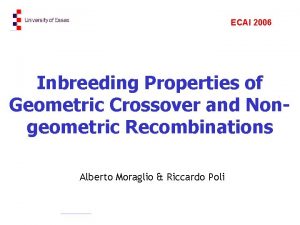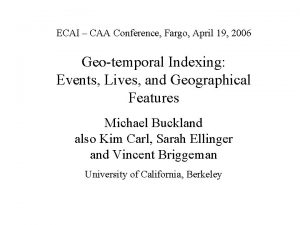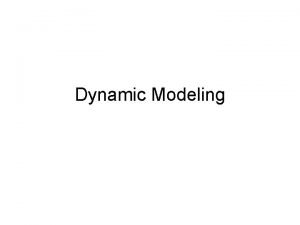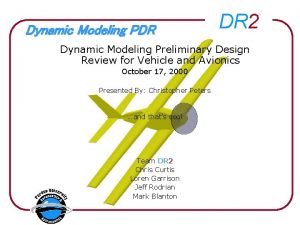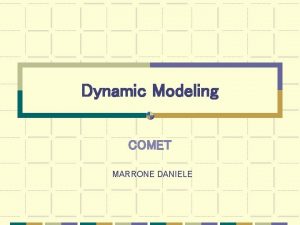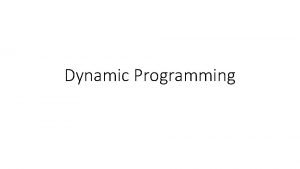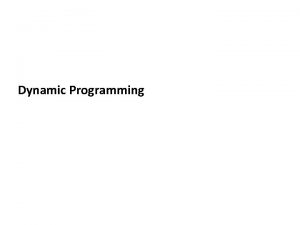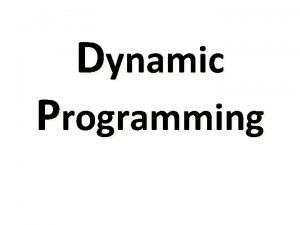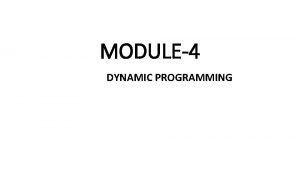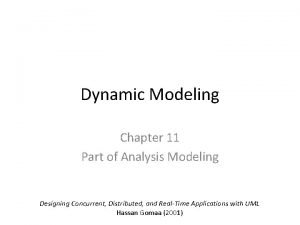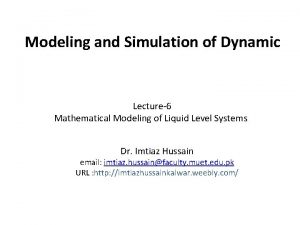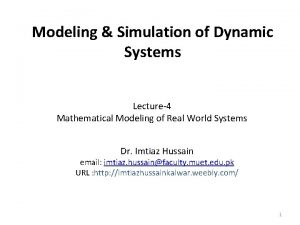ECAI 16 Tutorial T 11 NetworkOriented Modeling Dynamic













































































































































































- Slides: 173

ECAI’ 16 Tutorial T 11 Network-Oriented Modeling: Dynamic Modeling Based on a Temporal-Causal Network Modeling Approach Jan Treur Vrije Universiteit Amsterdam Department of Computer Science Behavioural Informatics Group 1

Most Detailed Reference: Treur, J. , Network-Oriented Modeling: Addressing Complexity of Cognitive, Affective and Social Interactions. Springer Publishers, October 2016. http: //www. springer. com/gp/book/9783319452111 From the publisher’s Website: q q q Provides a generic, unified approach to Network-Oriented Modeling Addresses the dynamics and adaptive aspects of causal relations by means of adaptive temporal-causal networks Makes it easy to incorporate theories and findings from Cognitive, Affective and Social Neuroscience into modeling 2

Network-Oriented Modeling: Webinfo on This Tutorial You can download: q These slides http: //www. few. vu. nl/~treur/ECAI 16 tutorial. Network. Oriented. Modeling. Slides. pptx q Per part references to the Network-Oriented Modeling book and to one or more papers with downloadable full text http: //www. few. vu. nl/~treur/ECAI 16 tutorial. Network. Oriented. Modeling. docx 3

Overview q Addressing Complexity of Mental and Social Processes q q Network-Oriented Modeling and Dynamics q q q Modeling integration of emotion in all mental and social processes Modeling integration of individual mental processes and social interaction Adaptive Temporal-Causal Network Models q q q Conceptual and numerical representations Examples of Temporal-Causal Network Models: q q Temporal-causal network models Temporal-Causal Network Models q q Separation assumptions and the Network-Oriented alternative Modeling plasticity of mental processes Modeling evolving social interactions Overview of Further Topics 4

Addressing Complexity of Human Mental and Social Processes Separation Assumptions and the Network-Oriented Alternative q Network-Oriented Modeling book, Chapter 1 q Treur, J. , Network-Oriented Modelling and its Conceptual Foundations. In: Proc. of the 8 th International Conference on Social Informatics, Soc. Info'16. Lecture Notes in AI, Springer Publishers, 2016, to appear. pdf file

Addressing Complexity by Separation Assumptions Isolation or separation assumptions are common in all disciplines and have often turned out very useful q Example from Physics: gravitation forces from more distant objects in the universe are neglected q In how far is it reasonable to address complexity of human mental and social processes by such assumptions? q 6

Separation Assumptions to Address Human and Social Complexity Examples of separation assumptions traditionally made to address human mental and social complexity: q q q mind cognition individual adaptive earlier versus versus body emotion collective processes non-adaptive processes later (temporal separation) However, these are more and more debated. 7

Problems with Separation Assumptions: Mind versus Body Aristotle (350 BC) considered properties of ‘mind and desire’ or ‘things in the soul’ as the cause of motion of a living being: Mind Body Mental Causation But how can Mind move physical things? Telekinesis? Against Physics and its laws! Proposed solution: Mind Brain and Brain moves Body But this only works if Brain is embodied: fully interwoven with Body. So: Mind Body and not Mind versus Body?

Problems with Separation Assumptions: Mind versus Body Example: generating feelings Traditional view: stimulus sensory representation felt emotion preparation for body state expressed emotion in body state James and Damasio claim a different causal chain: stimulus sensory representation preparation for body state expressed emotion in body state sensed body state representation of body state felt emotion Body is fully involved in generating a feeling, not 9 only brain.

Problems with Separation Assumptions: Cognition versus Emotion Another assumption made traditionally is that cognitive processes can be described independently, leaving affective states aside. This assumed separation between cognition and emotion has been questioned more and more. ‘The mechanisms of emotion and cognition appear to be intertwined at all stages of stimulus processing and their distinction can be difficult. (. . ) Adding the complexity of emotion to the study of cognition can be daunting, but investigations of the neural mechanisms underlying these behaviors can help clarify the structure and mechanisms. ’ 10 (Phelps, 2006, pp. 46 -47)

Problems with Separation Assumptions: Individual versus Collective Processes Individual processes: Psychology Collective processes: Social Science Often in different faculties, and in different buildings Study of social processes as patterns emerging from interactions between individuals, thereby abstracting from the processes within each of the individuals. The new discipline Social Neuroscience has shed new light on this seeming paradox of individual versus collective. Core concepts: mirror neurons and 11 internal simulation of the other’s mental processes.

Problems with Separation Assumptions: Adaptive versus Nonadaptive Processes Often processes are considered nonadaptive whereas in reality they are adaptive. Two examples: q Dreaming q q q As just watching a movie As exercising and learning in emotion regulation Social interactions q q Social interactions leading to contagion of states 12 Similarity of states leading to social interactions

Problems with Separation Assumptions: Earlier versus Later (Temporal Separation) Traditionally made separation assumption: mental processes are separated in time. For example: sensing – sensory processing – preparing for action – executing action However, in reality all these processes take place simultaneously, in parallel Also recall the loop in generating a feeling 13

Addressing Complexity by Interaction in Networks Instead of by Separation q q The separation assumptions to address human complexity are strongly debated The problem is not in the specific separation assumptions, but in the very idea of separation Processes and interactions take place all the time, simultaneously, in parallel This holds for social interactions as well as for mental and brain processes, and in fact for all processes in the real world 14

Addressing Complexity by Interaction in Networks Cyclic patterns in the brain: recursivity, no linear causality ‘Because of the constant recursivity of the process, the widespread notion of linear causality (a single cause for a single effect) cannot be applied to these mechanisms. (…), as is generally the case in self-organizing systems, there is no simple, unidirectional sense of causality. ’ (Scherer, 2009, p. 3470) 15

Addressing Complexity by Interaction in Networks Cyclic patterns of mental events: causal roles of mental states in Philosophy of Mind ‘… a mental state can be characterized in terms of the inputoutput relations it mediates, where the inputs and outputs may include other mental states as well as sensory stimuli and physicalinput: behaviors. output: Mental events impacts are on conceived as nodes in a complex impactscausal of painthe state networkpain thatstate engages in causal transactions with outside winces world by receiving sensory inputs and emitting behavioral outputs’ tissue damage groans (Kim, 1996, p. 104) pain state escaping

Addressing Complexity by Interaction in Networks Cyclic patterns of mental events: input: Philosophy of Mind output: impacts of state S 1 1 ‘Buton this seems to involve us in a Sregress or circularity: to 1 explain what a state given. Smental state is, we need to refer to other mental states, and explaining these can only be expected to require reference to further mental states, on so on – a process that can go on in an unending regress, or state S 2 output: loop back in a circle’ input: impacts (Kim, 1996, pp. 104 -105) on state S 2 impacts of state S 2 loop back 17

Addressing Complexity by Interaction in Networks Addressing social complexity network based on interaction by telephone calls (Giles, 2012) 18

Addressing Complexity by Interaction in Networks Addressing social complexity: organization modeling ´The study of the process-type of organization (…) can benefit from certain network-oriented modeling formalisms because of the very nature of the organizational concept. (…) addressing (. . . ) the specific coordinating problems of the adaptively interrelated distributed-action organizational units as they are found in process-based organizational models. ´ (Elzas, 1985, p. 162) 19

Addressing Complexity by Interaction in Networks Addressing social complexity: modeling societies ‘… the challenges of modeling and assessing spatially complex human-ecosystem interactions, and the need to simultaneously consider rural-urban and rich-poor interactions. (…) Instead of rigid rural-urban dichotomies and other absolute, “container” views of space, there is a need to recognise spatial overlaps and complexities such the pervasiveness of so-called translocal livelihood systems. Accordingly, much more relational, network-oriented modeling approaches are needed. ’ (Naudé, Le Maitre, de Jong, Mans, and Hugo, 2008, p. 1) 20

Network-Oriented Modeling Summary: Shortcomings of traditional means to address complexity by assuming separation of processes q The cyclic, interactive and distributed character of real world processes are an important challenge q In particular this holds for human mental and social processes q A perspective based on interactions in networks is more suitable q 21

Network-Oriented Modeling takes the concept of network and the interactions within a network as a basis for conceptualization of any processes q Network-Oriented Modeling is not considered as modeling of (given) networks, but modeling any complex processes by networks q 22

Network-Oriented Modeling Network as a modeling concept: q easy to visualize q good support for intuition q covers locality of impact principle q can cover dynamics and adaptivity q very wide applicability; e. g. , all domains based on: q q causal relations dynamical systems (or described by systems of first-order differential equations) 23

Network-Oriented Modeling Historically the concept network has been used for studying processes such as: q q q processes in engineering in Physics; e. g. , (Van Dyke, 1928; Hubbard, 1931; Bode, 1945) processes in Human Physiology; e. g. , (Huber, 1941; Wiener, Rosenblueth, 1946) processes in engineering in Chemistry; e. g. , (Treloar, 1943; Flory, 1944) brain processes in Neuroscience by neural networks; e. g. (Mc. Culloch and Pitts, 1943; Rosenblatt, 1958) metabolic processes in Cell Biology by metabolic networks; e. g. , (Ouellet and Benson, 1951; Westerhoff et al. , 1984) social interactions within Social Science by social networks; 24 e. g. , (Bott, 1957; Aldous and Straus, 1965; Gutkind, 1965)

Network-Oriented Modeling and Dynamics Temporal-Causal Network Models q Network-Oriented Modeling book, Chapter 1 q Treur, J. , Network-Oriented Modelling and its Conceptual Foundations. In: Proc. of the 8 th International Conference on Social Informatics, Soc. Info'16. Lecture Notes in AI, Springer Publishers, 2016, to appear. pdf file

Dynamics in Network-Oriented Modeling The Dynamical Approach to Modeling Cognitive Systems ‘The alternative, then, is the dynamical approach. Its core is the application of the mathematical tools of dynamics to the study of cognition. (…) But the dynamical approach is more than just powerful tools; like the computational approach it is a worldview. The cognitive system is not a computer, it is a dynamical system. (…) The cognitive system is not a discrete sequential manipulation of static representational structures; rather, it is a structure of mutually and simultaneously influencing change. ’ (van Gelder and Port, 1995, p. 3). 26

Dynamics in Network-Oriented Modeling The Dynamical Approach to Modeling Cognitive Systems ‘Although the idea of applying dynamical systems theory to the study of neural and cognitive mechanisms has been around for at least two decades (…), the dynamical systems approach has only recently begun to figure prominently in neuroscience (…). ’ (Schurger and Uithol , 2015, Section 6, first paragraph) 27

Network-Oriented Modeling Based on Temporal-Causal Networks q Addresses dynamics in Network-Oriented Modeling: q q incorporates a continuous time dimension to model dynamics of states and connections a generic and declarative dynamic AI modeling approach based on cyclic networks of causal relations adaptive elements can be fully integrated 28

Network-Oriented Modeling Based on Temporal-Causal Networks q can incorporate ingredients from different modeling approaches; e. g. , ingredients used in q q q modeling by networks of social interactions specific types of (continuous time, recurrent) neural network models probabilistic or possibilistic modeling 29

Network-Oriented Modeling Based on Temporal-Causal Networks Conceptual and Numerical Representations q Network-Oriented Modeling book, Chapter 2 q Treur, J. , Dynamic Modeling Based on a Temporal-Causal Network Modeling Approach. Biologically Inspired Cognitive Architectures, 16, 131 -168 (2016) Research. Gate doi pdf file

Network-Oriented Modeling Based on Temporal-Causal Networks q Temporal-causal network models can be represented equivalently by a: q q q conceptual representation (e. g. , labeled graph or matrix) numerical representation (difference equations) These representations can be used for: q q numerical simulation mathematical analysis validation by comparing to empirical data or properties tuning of parameters to characteristics of domain, person, or social context 31

Temporal-Causal Networks: Sources for Inspiration and Unification metabolic networks used as a conceptual structure to model biochemical reactions in cell biochemistry q networks of mental states used as conceptual structures to model mental processes as considered within Cognitive and Affective Neuroscience and Philosophy of Mind q social networks used as a conceptual structure to model social interaction q 32

Social Network Structure B F A E C J K G D H I 33

Social Network Structure B F A E C J K G D H I 34

Network for Internal and External Interaction Processes B F A E C J K G D H I 35

Network for Internal and External Interaction Processes 36

Network for Internal and External Interaction Processes 37

Network for Internal and External Interaction Processes 38

Network for Internal and External Interaction Processes B F A E C J K G D H I 39

Dynamics and Adaptivity in Networks From Social Science: Dynamics of mutual influences of the persons on each other following the social network structure (modelled as contagion within a social network model) q Dynamics of the connections between persons; they may become stronger or weaker over time, or disappear or appear (modelled as an adaptive social network model) q 40

Evolving Apple Inventor Network 41

Evolving Co-Authorship Network 42

Dynamics and Adaptivity in Networks From Cognitive Neuroscience: Many parts in the brain are connected by cyclic connections q Assumed to play an important regulatory role in the brain’s processes q These connections are adaptive: their strengths can change over time (plasticity), a basis for learning q 43

Network-Oriented Modeling Based on Temporal-Causal Networks What is Needed to Describe a Model in a Conceptual Representation? 44

Temporal-Causal Networks in a Conceptual Representation: What is Needed to Describe a Model? (1) Strength: not all causal relations are equally strong some notion of strength of a connection is needed 45

Temporal-Causal Networks in a Conceptual Representation: What is Needed to Describe a Model? (2) Combination: when multiple causal relation affect a state, in which manner do their effects combine? some way to aggregate multiple causal impacts on a state is needed 46

Temporal-Causal Networks in a Conceptual Representation: What is Needed to Describe a Model? (3) Timing: not every state has the same extent of flexibility; some may be able to change faster than other states a notion of speed of change of a state is needed 47

Network-Oriented Modeling Based on Temporal-Causal Networks Basic elements of a temporal-causal network model: q q States and connections Activation levels of states and weights of connections Combination functions for aggregation of multiple causal impacts on a state Speed factors for timing of causal impact on a state 48

Network-Oriented Modeling Based on Temporal-Causal Networks Combination functions have similarity to the functions used in a static manner to define models from the (deterministic) Structural Causal Model perspective (Wright, 1921; Pearl, 2000; Mooij et al. , 2013) But in the Network-Oriented Modelling approach based on temporal-causal networks combination functions are used in a dynamic manner 49

Temporal-Causal Networks in a Conceptual Representation: What to Specify to Obtain a Model? 50

Temporal-Causal Networks in a Conceptual Representation: What to Specify to Obtain a Model? P Q Q c. Q(. . ) Connection weight P, R Speed R Q, R R, S factor R Combination function c. R(. , . ) S S c. S(. . ) S, U R, T T c. R(. , . ) c. T(. . ) T T, U R T, V U U c. U(. , . ) V V c. V(. . ) V, Q 51

Temporal-Causal Networks in a Conceptual Representation: What to Specify to Obtain a Model? names for states Y q directed connections (arrows) between states X and Y q q for a connection from state X to state. Y a weight value X, Y Y for each of the nodes Y a speed factor q for each of the nodes Y a combination function that takes multiple impacts and provides one aggregated impact; c. Y(. , . ) such a combination function can be indicated by referring to a standard combination function (e. g. , by giving the name of it) q These elements can be described in different conceptual representations or formats: graphical, matrix, XML, comma separated file, … 52

Temporal-Causal Networks: Generic Graphical Conceptual Representation P Q Q c. Q(. . ) P, R Q, R R R, S S S c. S(. . ) S, U R R, T T c. R(. , . ) c. T(. . ) T T, U T, V U U c. U(. , . ) V V c. V(. . ) V, Q 53

Temporal-Causal Networks: Specific Graphical Conceptual Representation P Q Q c. Q(. . ) 0. 5 0. 3 R 0. 4 S S c. S(. . ) -0. 2 R 0. 9 T c. R(. , . ) c. T(. . ) T 0. 7 1. 0 U U c. U(. , . ) V V c. V(. . ) 0. 8 54

Temporal-Causal Networks: Specific Graphical Conceptual Representation P Q 0. 1 id(. ) 0. 5 0. 3 R 0. 4 S id(. ) 0. 4 0. 9 0. 4 sum(. , . ) id(. ) T -0. 2 0. 7 1. 0 U 0. 1 sum(. , . ) V 0. 1 id(. ) 0. 8 55

Temporal-Causal Networks: Generic Conceptual Matrix Representation to P Q R S T U V from P, R P Q, R Q R, S R, T R S, U S T, U T, V T U V, Q V Y P Q R S T U V 56 c. Y(…) c. P(…) c. Q(…) c. R(…) c. S(…) c. T(…) c. U(…) c. V(…)

Temporal-Causal Networks: Specific Conceptual Matrix Representation to from P Q R S T U V Y c. Y(…) P Q R S T 0. 4 0. 9 U V 0. 5 0. 3 -0. 2 0. 7 1. 0 0. 1 0. 8 - - 0. 1 0. 4 id(. ) sum(. , . ) id(. ) 57

Tranformations Between Different Conceptual Representations of a Model conceptual representations matrix representation of a model graphical representation of a model They are equivalent conceptual representations: they contain exactly the same information 58

Example Model: How to Choose Names? world state icecream for stimulus s sensor state seeing for stimulus s icecream sensory representation state preparation state mental image of preparation to get for action a for stimulus s the icecream execution state getting the for action a icecream sensory what if I wouldof representation have the icecream predicted effect e 59

How to Choose Names? State names for the nodes of the temporal-causal network: Every state a specific state name (letters, words) q Uniform numbered state names; e. g. , S 1, . . , S 5 or Y 1, …, Y 5 q State names structured according to different groups of states q 60

Example Model: State Names Structured According to Different Groups world state for stimulus s sensory representation state preparation state for action a for stimulus s execution state for action a sensory representation of predicted effect e 61

Example Model: State Names Structured According to Different Groups group description group name state names per group world states sensory representation states preparation states execution states ws ss srs ps es wss srss, srse psa esa Alternatives for the subscript ws(s), ws_s, ss(s), ss_s, … 62

Example Model: State Names Structured According to Different Groups world state for stimulus s sensory representation state preparation state for action a for stimulus s execution state for action a sensory representation of predicted effect e 63

Example Model: State Names Structured According to Different Groups wss srss psa esa srse 64

State Names Structured According to Different Groups in a Generic Matrix Representation to from wss srse psa esa wss, sss wss srss srse psa esa Y c. Y(…) sss, srss, psa srse, psa, srse - sss csss(V) srss csrss(V) srse csrse(V) psa, esa psa cpsa(V 1, V 2) esa cesa(V 65 )

How to Choose Names? Connections and Their Weights Connection from state X to state Y q Implicitly, by using the states: connection (X, Y); weight X, Y q Giving connections their own names: q q by numbering them 1, 2, …; weights 1, 2, … by choosing meaningful names such as sensing, representing, responding, predicting, executing; weights sensing, representing, … 66

Example Model: Implicit Naming of Connections and Weights wss, sss, srss srse srss, psa, esa srse, psa, srse 67

Example Model: Numbered Connections wss 1 sss 2 srss srse 3 psa 6 esa 4 5 68

Example Model: Numbered Connection Weights wss 1 sss 2 srss srse 3 psa 6 esa 4 5 69

Example Model: Informative Connection Names wss sensing sss representing srss srse responding psa executing esa amplifying predicting 70

Generic Example Model: Informative Weight Names in Graphical Representation wss sensing sss representing srss srse responding psa executing esa amplifying predicting 71

Generic Example Model: Informative Weight Names in Matrix Representation to from wss srse psa esa sensing wss srss srse psa esa Y c. Y(…) sss representing responding amplifying predicting - sss csss(V) srss csrss(V) srse csrse(V) executing psa cpsa(V 1, V 2) esa cesa(V 72)

Referring to Speed Factors q q q Implicit naming: Numbering: Informative names: Y for state with name Y 1 , 2 slow, fast 73

Referring to Combination Functions Implicit naming c. Y(. . . ) for state with name Y q Informative name: q standard names: id(. ), sum(. . ), slogistic(. . ), alogistic(. . ), … q own chosen names: …. . q 74

Indicating Boundaries Between Internal and External Processes wss sensing sss representing srss srse responding psa executing esa amplifying predicting 75

Different Representations of a Model and Tranformations Between Them conceptual representations matrix representation of a model graphical representation of a model numerical representations difference equation representation of a model differential equation representation of a model 76

Systematic Generation of a Numerical Representation from a Conceptual Representation Can this be automated by an application program? Input: q states and weights X, Y of connections between them q a speed factor Y for each state Y q combination functions c. Y(. . . ) for each state Y Output: q for each state Y a numerical representation (formula) by which from a current state value Y(t) at time t a next state value Y(t+ t) at time t+ t can be calculated; 77 these formulae can be used for simulations

Dynamics of a State Y: Impact of One State X on a State Y impact other state X state Y X, Y X(t) = impact. X, Y(t) + Y [ X, Y X(t) – Y(t)] t Y(t) X, Y X(t) – Y(t) Y [ X, Y X(t) – Y(t)] t Y(t+ t) state X state Y Impact of X on Y at t: Y(t+ t) = Y(t) + Y [impact. X, Y(t) – Y(t)] t impact. X, Y(t) = X, Y X(t) 78

Dynamics of a State other state X impact state Y X, Y In 1 st order difference equation representation: Y(t+∆t) = Y(t) + Y [impact. Y(t) – Y(t)] t Y(t+∆t) = Y(t) + Y [ X, Y X(t) – Y(t)] t If and then at time t the activation level of state X is V 1 the activation level of state Y is V 2 at time t+ t the activation level of state Y will be V 2 + Y [ X, Y V 1 – V 2] t 79

Dynamics of a State other state: X impact state Y X, Y In difference equation format: Y(t+∆t) = Y(t) + Y [ X, Y X(t) – Y(t)] t In differential equation representation ( t small): Y(t+∆t) - Y(t) = Y [ X, Y X(t) – Y(t)] t Y(t) / t = Y [ X, Y X(t) – Y(t) ] d. Y(t) /dt = Y [ X, Y X(t) – Y(t) ] d. Y/dt = Y [ X, Y X – Y ] 80

Dynamics of a State Based on Aggregated Impact other states Xi state Y impact. Xi, Y Impacts on state Y aggregation of impact other states aggimpact. Y Aggregated impact on state Y 81

How to Determine Aggregated Impact Numerically First multiply the state value Xi(t) of each state Xi (i = 1, 2, . . , k) with impact on Y by the weight Xi, Y of the connection from Xi to Y: VXi, Y = Xi, Y Xi (t) = impact. Xi, Y impact of Xi on Y Next, combine these impact values VXi, Y for the different states Xi, for example, by a sum combination function sum(…): aggimpact. Y = sum(impact. X 1, Y, … , impact. Xk, Y) = impact. X 1, Y + … + impact. Xk, Y = VX 1, Y + … + VXk, Y = X 1, Y X 1(t) + … + Xk, Y Xk(t) 82

How to Determine Aggregated Impact Numerically More in general any combination function c. Y (…) can be used: aggimpact. Y = c. Y (impact V 1 X 1, Y, …, impact Vk Xk, Y) = c. Y ( X 1, Y X 1, …, Xk, Y Xk ) 83

Dynamics of a State Based on Aggregated Impact Change the current value of state X in the direction of the value of the aggregated impact aggimpact. Y = c. Y ( X 1, Y X 1, …, Xk, Y Xk ) Difference equation representation: Y(t+∆t) = Y(t) + Y [aggimpact. Y(t) – Y(t)] t Differential equation representation: d. Y /dt = Y [aggimpact. Y - Y ] 84

How to Get a Numerical Representation from a Conceptual Representation Summary of the systematic method For any state Y 1. Determine the multiple impacts on Y by multiplying the values X 1(t), . . for X 1, . . connected to Y by the connection weights X 1, Y , . . : impact. X 1, Y (t), … = X 1, Y X 1(t) , … 2. Aggregate the impacts by the combination function c. Y (. . ): aggimpact. Y (t) = c. Y (impact. X 1, Y (t), . . ) 3. Incorporate timing by using the speed factor Y : and t Y [aggimpact. Y (t) – Y(t)] t 4. Obtain the difference equation: 85 Y(t+∆t) = Y(t) + Y [aggimpact. Y(t) – Y(t)] t

Icecream Example wss sensing sss representing srss srse responding psa executing esa amplifying predicting 86

Numerical Representation for the Example Model LPpsa Preparing for a response: determining values for psa(t+ t) = psa(t) + psa [cpsa( responding srss(t)), amplifying srse(t)) - psa(t) ] t By choosing a sum combination function sum(V 1, V 2) = V 1 + V 2 cpsa(V 1, V 2) = sum(V 1, V 2) = V 1 + V 2 this becomes psa(t+ t) = psa(t) + psa [ responding srss(t) + amplifying srse(t) - pa(t) ] t 87

Automated Transformation: Conceptual Numerical Representation Up till now the following options have been developed: q Excel template based on a conceptual matrix representation q q q Java program based on a conceptual representation in XML q q q Different combination functions built in: identity, sum, scaled sum, simple logistic, advanced logistic Some limitation in number of states Only identity and logistic sum function built in No limitation in number of states i. Pad app based on a conceptual graphical representation q q Some limitation in number of states Only identity and logistic sum function built in 88

Automated Transformation: Conceptual Numerical Representation q Matlab template based on a conceptual matrix representation q q q Different combination functions built in: identity, sum, scaled sum, simple logistic, advanced logistic No limitation in number of states Python environment based on a conceptual matrix representation q q Different combination functions built in: identity, sum, scaled sum, simple logistic, advanced logistic No limitation in number of states 89

Applying Computational Methods to Temporal-Causal Models; Some Examples Conceptual representation Numerical representation Qualitative causal reasoning Network analysis Forward simulation, backward simulation Verification of equilibria, monotonicity Conceptual validation Identification of qualitative personal or contextual characteristics in the context of empirical information Numerical validation Identification of quantitative personal or contextual characteristics in the context of empirical information Conceptual analysis or diagnostics of a Numerical analysis or diagnostics of a process Conceptual planning of actions or Numerical planning of actions or 90 interventions as part of some

Example Model Simulation Based on a Numerical Representation 1, 2 world state for s sensor state for s 1, 0 sensory representation for s preparation state for action a sensory representation for effect e 0, 8 execution state for action a 0, 6 0, 4 0, 2 0, 0 0 5 10 15 20 25 30 35 40 45 50 5591 60

Another Example: Social Contagion in a Social Network A Simple Model with Only Single States per Person A connection from person X to person Y is modelled by a connection weight X, Y in the interval [0, 1] B L F A E C J G D K H I 92

Simple Model with Only Single States per Person: Connection Weights X, Y Y to A from A X B C D E 0. 6 0. 8 1 0. 5 2. 9 0. 4 0. 8 1. 9 B 0. 7 C 0. 5 D 0. 6 E 0. 3 0. 5 0. 4 F 0. 6 G F 1 H I 0. 4 0. 8 0. 7 2. 5 0. 7 0. 3 0. 7 0. 2 0. 3 0. 5 I 0. 9 K 2. 4 0. 3 1 J 0. 9 0. 3 0. 1 H 0. 1 0. 4 0. 8 2. 6 0. 2 0. 4 0. 7 K 0. 3 0. 2 0. 3 0. 9 directly received 2. 1 1. 7 2. 2 2. 6 3. 2 2. 7 influence 1. 8 0. 5 2. 2 1. 9 0. 7 2. 7 0. 2 1. 1 0. 8 0. 9 2 1. 8 0. 2 1 J L G directly L exerted influence 2. 2 1. 5 2. 3 2. 8 1. 1 2. 6 93

Simple Social Contagion Model with Single States per Person The last row shows the sums of the weights per column for person B: B = A 1, B + … + Ak, B This number B can be interpreted as the weight of the overall direct influence received by person B within the network 94

Simple Social Contagion Model with Single States per Person Generic numerical representation: d. XB(t) / dt = B [aggimpact. B (t) - XB(t)] XB(t+ t) = XB (t) + B [aggimpact. B (t) - XB (t)] t with aggimpact. B (t) = c. B ( A 1, B XA 1(t), …, Ak, B XAk (t)) d. XB(t) / dt = B [c. B ( A 1, B XA 1(t), …, Ak, B XAk (t)) - XB(t)] XB(t+ t) = XB (t) + B [c. B ( A 1, B XA 1(t), …, Ak, B XAk (t)) - XB (t)] t 95

Simple Social Contagion Model with Single States per Person Scaled sum combination function: ssum (V 1, . . , Vk) = (V 1 +. . + Vk ) / Choosing this combination function with scaling factor B gives a weighted average of the values XA 1(t), …, XAk (t): c. B ( A 1, B XA 1(t), …, Ak, B XAk (t)) = = ( A 1, B XA 1(t) + … + Ak, B XAk (t)) / B = ( A 1, B / B) XA 1(t) + … + ( Ak, B / B) XAk (t) 96

Simple Social Contagion Model with Single States per Person Numerical representation with scaled sum combination function with scale factor B d. XB(t) / dt = B [( A 1, B XA 1(t) + … + Ak, B XAk (t)) / B - XB(t)] X B( t + t ) = X B ( t ) + B [ ( A 1, B XA 1(t) + … + Ak, B XAk (t)) / B - XB (t)] t 97

Simple Contagion Model with Single States per Person: Example Simulation 1, 2 1, 0 0, 8 0, 6 X 1 X 2 X 3 0, 4 X 5 X 6 0, 2 X 7 X 8 X 9 X 10 0, 0 0 10 20 30 40 50 60 70 80 90 100 110 120 98

Examples of Combination Functions Examples of combination functions c(…) Identity combination function id(V) = V Sum combination function sum(V 1, …, Vk) = V 1 + … +Vk Scaled sum combination function with scaling factor ssum (V 1, …, Vk) = (V 1 + … +Vk )/ 99

Examples of Combination Functions Simple logistic sum function slogistic , (V 1, …, Vk) = 1/(1+e- (W- )) with steepness, threshold, W = V 1 + … + Vk Advanced logistic sum function alogistic , (V 1, …, Vk) = [1/(1+e- (W- )) - 1/(1+e ) ] (1+e- ) 100

Simple Logistic Function Threshold = 1 Steepness = 10 1 0, 8 0, 6 0, 4 0, 2 5 2, 2 25 2, 00 00 00 1, 75 00 00 00 01 5 1, 1 25 1, 00 5 5 00 00 0, 25 0, 75 0, 0 0 101

Simple Logistic Function Threshold = 1 Steepness = 2 1 0, 8 0, 6 0, 4 0, 2 5 2, 2 75 1, 25 1, 1 00 00 00 5 5 0, 25 0, 75 0, 0 0 102

Advanced Logistic Function Threshold = 1 Steepness = 2 1 0, 8 0, 6 0, 4 0, 2 5 2, 2 75 1, 25 1, 1 00 00 00 5 5 0, 25 0, 75 0, 0 0 103

Overview of Standard Combination Functions and Their Properties name description formula CFP 1 CFP 2 CFP 3 CFP 4 CFP 5 Preservation of zero impact Nonnegative Upward bounded by 1 Monotonic Keeps states within [0, 1] V 1 + … + V k Yes If all Vi ≥ 0 Depends Yes If all j, i ≥ 0 & j j, i ≤ 1 V 1 * … * Vk 1 – (1 - V 1)* …*(1 – Vk) Yes If all Vi ≥ 0 If all Vi ≤ 1 Yes If all Vi ≥ 0 min(V 1, …, Vk) max(V 1, …, Vk) Yes If all Vi ≥ 0 If all Vi ≤ 1 Yes If all Vi ≥ 0 with , >0 No Yes Yes Advanced logistic sum [(1/(1+e - (V 1+. . +Vk - )) (1/(1+e ))] (1+e - ) with , >0 Yes Yes If all Vi ≥ 0 Scaled sum (V 1 + … + Vk)/ Yes If all Vi ≥ 0 Depends Yes (V 1 + … + Vk) / + ij ij Vi. Vj with >0 If all j, i ≥ 0 & ≤ 1/ j j, i Yes Depends cproduct(V 1, …, Vk) with 0≤ ≤ 1 + (1 - ) product(V 1, …, Vk) Yes Yes If all Vi ≥ 0 max(V 1, …, Vk) + (1 - ) min(V 1, …, Vk) Yes Yes c(V 1, …, Vk) = SCF 1 sum SCF 2 product cproduct SCF 3 min max SCF 4 slogistic SCF 5 alogistic SCF 6 ssum SCF 7 sisum SCF 8 aproduct SCF 8 aminmax Sum Product Complement product Minimal value Maximal value Simple logistic sum Scaled sum with interaction terms Advanced product Advanced minimum and maxumum 1/(1+ e - (V 1+. . +Vk - )) with >0 with 0≤ ≤ 1 104 If all Vi ≥ 0

Examples of Temporal-Causal Network Models Modeling the Integration of Emotion in all Mental and Social Processes q Network-Oriented Modeling book, Chapter 3 q Treur, J. , An Integrative Dynamical Systems Perspective on Emotions. Biologically Inspired Cognitive Architectures Journal, 4, 27 -40, 2013. doi pdf file

Introduction From the beginning Artificial Intelligence has addressed the modelling of cognitive processes behind intelligence q The original practice was that emotions were avoided; emotions were assumed to disturb the ideal intelligence q However, even in the 1960 s from the cognitive area it was pointed out that this was a serious omission when human intelligence is aimed at q 106

Introduction This situation in Artificial Intelligence has substantially changed (only) in recent years q Reasons for this change: q q q the need for human-like models as a basis for virtual agents, or in Ambient Intelligence applications the strong development of neuroscience showing that in most human processes emotions provide a constructive, and not a disturbing contribution 107

Introduction Questions: q q Does a feeling affect an expressed emotion or the other way around? In which way is it possible to control emotion? How does desiring relate to feeling? In how far do sensing and believing relate to feeling? 108

Introduction More questions: q q q How does having experiences over time relate to experiencing emotions? Can you make an adequate decision without feeling good about it? In how far is an individual in a group free in having own emotions? 109

Emotional Responses and Feelings Damasio (1994, 1999) pointed at the possibility of an as-if body loop bypassing actually expressed bodily changes: stimulus sensory representation preparation for bodily changes sensory representation of a changed body state felt emotion Internally simulated body change 110

Internal Simulation: Emotions and Feelings Internal simulation and feeling emotions: sensory representation of s → preparation for body state b sensory representation of b = basis for feeling b These are as-if body loops (Damasio, 1994; 1999); body loops occur when the body state is also expressed. 111 b From stimulus s to feeling an emotion

Emotional Responses and Feelings: Graphical Conceptual Representation sensing stimulus s sss representing sensory representation of stimulus s srss responding amplifying preparation state for b as-if body loop psb feeling b state fsfor b b 112

Emotion Regulation In which way is it possible to control emotion? Controlling or regulating your emotion often associated to suppressing an emotional response; for example, expressing a neutral poker face q however, the mechanisms to regulate emotions form a much wider variety; for example, closing or covering your eyes when a movie is felt as too scary, or avoiding an aggressive person are different forms of control q 113

Emotion Regulation Emotion regulation mechanisms (Gross, 1998) q antecedent-focused regulation q q selection and modification of the situation attentional deployment reappraisal (change your interpretation) response-focused regulation q suppression of a response 114

Emotion Regulation: Graphical Conceptual Representation monitoring representation of s stimulus s representing control state for b monitoring response b suppressing emotion regulation representation response b loop of s responding sensory preparation representation of stimulus s state for b amplifying as-if body monitoring suppressing feeling loop feeling b feeling state for b 115

Interaction Between Cognitive and Affective States Examples of questions about such interactions are: how does desiring relate to feeling q in how far do sensing and believing relate to feeling? q 116

Interaction Between Cognitive and Affective States: Conceptual Representation cognitive state c responding interpreting emotion integration stimulus s representing sensory representation of stimulus s responding preparation state for b amplifying feeling state for b 117

Emotion-Related Valuing in Decision-Making ‘Throughout recorded human intellectual history there has been active debate about the nature of the role of emotions or ‘passions’ in human behavior, with the dominant view being that passions are a negative force in human behavior (…). By contrast, some of the latest research has been characterized by a new appreciation of the positive functions served by emotions’ (Loewenstein and Lerner, 2003) Can you make an adequate decision without feeling good about it? 118

Emotion-Related Valuing in Decision-Making: Graphical Conceptual Representation stimulus s sensory representation of predicted effect e preparation state for a valuing loop preparation state for b as-if body loop feeling emotion-related state valuation v forfor ab 119

Emotions and Social Contagion Person A responds by showing emotion b (for example, a smile) both to a stimulus s (for example, a funny picture) or to observing person B showing b: sensor state of person A for stimulus s person A shows b sensor state of person A for person B showing b person A shows b The same applies to person B with respect to person A: sensor state of person B for stimulus s person B shows b sensor state of person B for person A showing b person B shows b 120

Examples of Temporal-Causal Network Models Modeling Integration of Individual Mental Processes and Social Interaction q Network-Oriented Modeling book, Chapter 7 q Treur, J. , Biological and Computational Perspectives on the Emergence of Social Phenomena: Shared Understanding and Collective Power. Transactions on Computational Collective Intelligence, 8, 168 -191, 2012. pdf file

Mirror Neurons and Internal Simulation Seeming paradox: q each person is an autonomous entity with own beliefs, desires, emotions and intentions q nevertheless groups often develop coherent views and decisions and members feel good about it 122

Mirror Neurons and Internal Simulation Recent development of new discipline Social Neuroscience q Central theme: one person internally mirrors the internal processes of another person q Integration of mirroring process and other internal processes q Mirroring is based on two core concepts: q q q Mirror neurons Internal simulation 123

Existence of Mirror Neurons First discovered by accident for monkeys in Parma in the 1990 s q Mirror neuron = neuron active both when preparing for an action (or body state) and when observing another person performing the action q 124

Mirror Neurons observing another person A performing a sensing stimulus s sensory representation of the observation of A performing a sensory representation of s preparation for a performing action a 125

Existence of Mirror Neurons Evidence was found for humans, first based on EEG, PET, f. MRI data, and recently also by single cell recording q New insight: to interpret somebody else’s action you prepare for this action q Preparation states can concern various types of action, among which expressing emotions on your face or body, showing a tendency, or talking q 126

Internal Simulation General pattern of internal simulation: sensory representation 1 → preparation 1 sensory representation 2 → preparation 2 …… action effect prediction links These are simulated perception-action chains; for example (Hesslow, 2002); e. g. , imagination or visualisation 127

Mirroring Process: Mirror Neurons and Internal Simulation Mirroring process: sensory representation of another person’s action a → preparation for a (mirror neuron) sensory representation of (predicted) effect b 128

Mirroring: Emotion Contagion For example: seeing somebody else’s emotion expression (smile) → preparation for this expression (mirror neuron) sensory representation of this expression (prediction) → feeling the emotion Emotion contagion 129

Modelling Social Contagion Based on Mirroring Processes Graphical conceptual representation for a behavioural view person A sensing b of person B person A’s sensor state for person B showing b person A’s sensor state for stimulus s person B’s sensor state for person A showing b A responding to b of B A responding to s person B sensing b of person A showing b person A person B’s sensor state for stimulus s B responding to b of A B responding to s person B showing b person B 130

Modelling Social Contagion Based on Mirroring Procses Graphical conceptual representation for an internal view person Y’s sensor state for b of person X Y showing b person Y’s sensory representation of person X showing b Y representing b of X person Y’s sensor state for stimulus s Y representing s Y responding to b of person X person Y’s preparation state for b Y responding to s person Y’s sensory representation for stimulus s person Y’s execution state for b Y executing Y amplifying person Y’s feeling state for b Y feeling 131

Mirroring: Who is in Control? Multiple functions of mirror neurons: preparing or observing, or both → strongly intertwined internal and external influences on your behaviour q Effective mechanism to “let” (? ) your own processes be affected or determined by others’ processes q 132

Mirroring: Who is in Control? Multiple functions of mirror neurons → the functional meaning of their activation is contextdependent (e. g. , preparing or observing, or both) q The context determines in which cases their activation is to lead to execution of the action q Part of this context is self-other distinction q A specific set of neurons serves as such a context and for example controls execution of a prepared action q 133

A Control State for Self-Other Distinction observing another person A performing a sensing stimulus s sensory representation of the observation of A performing a sensory representation of s For example, an empathic response for a = an emotion b control state for A does a preparation for a communication of A does a performing action a 134

Emergence of Collective Action: the Role of Emotion-Related Valuing Important role of the feeling states associated to actions q Collective action cannot be strong when individual feelings and valuations have much variation; emergence of strong collective action, needs a shared feeling and valuation for this action q Mirroring of the associated emotions makes that the collective action gets a solid shared emotional grounding q 135

Adaptive Temporal-Causal Network Models Modeling Plasticity of Mental Processes q Network-Oriented Modeling book, Chapter 2 q Treur, J. , Dynamic Modeling Based on a Temporal-Causal Network Modeling Approach. Biologically Inspired Cognitive Architectures, 16, 131 -168 (2016) pdf file Research. Gate doi

Adaptive Individual Characteristics Based on Hebbian Learning Hebbian learning principle (Hebb, 1949) ‘neurons that fire together, wire together’ X 1 1, 2 X 2 137

Dynamic Individual Characteristics Based on Hebbian Learning Basic assumptions: The added connection strength is in principle proportional to both X 1 and X 2: proportional to X 1 X 2 by a factor (learning rate) q The increase of 1, 2 is bounded by 1 using a logistic factor (1 - 1, 2) q There is extinction of the connection strength which is propertional to 1, 2 by a factor (extinction rate) q 138

Dynamic Individual Characteristics Based on Hebbian Learning Hebbian learning rule for the connection between states X 1 and X 2 1, 2(t + t) = 1, 2(t) + [ X 1(t) X 2(t) (1 - 1, 2(t)) - 1, 2(t) ] t d 1, 2 /dt = X 1 X 2 (1 - 1, 2) - 1, 2 activation levels X 1 and X 2 learning rate > 0 bounded by 1 extinction rate ≥ 0 139

Dynamic Individual Characteristics Based on Hebbian Learning Basic assumptions: The added connection strength is in principle proportional to both X 1 and X 2: proportional to X 1 X 2 by a factor (learning rate) q The increase of 1, 2 is bounded by 1 using a logistic factor (1 - 1, 2) q There is extinction of the connection strength which is propertional to 1, 2 by a factor (extinction rate) q Formalisation: 1, 2(t + t) = 1, 2(t) + [ X 1 X 2 (1 - 1, 2) - 1, 2 ] t learning bound extinction 140

Hebbian Learning Using States for Dynamic Connections 1 combination function 1, 2 1 X 1 1 11, 2 c 1, 2(V 1, V 2, W) = V 1 V 2 (1 – W) + (1 - )W 1 X 2 3, 2 X 3 141

Adaptive Temporal-Causal Network Models Modeling Evolving Social Interactions q Network-Oriented Modeling book, Chapter 11 q Sharpanskykh, A. , and Treur, J. , Modelling and Analysis of Social Contagion in Dynamic Networks. Neurocomputing Journal, 146, 140 -150 (2014) pdf file q Blankendaal, R. , Parinussa, S. , and Treur, J. , A Temporal-Causal Modelling Approach to Integrated Contagion and Network Change in Social Networks. In: Proc. of the 22 nd European Conference on Artificial Intelligence, ECAI'16. IOS Press. pdf file (Wednesday August 31, 15: 30, Session on AI in Social Media, Europe 1&2)

Models with Dynamic Network Characteristics Dynamic network characteristics: how do the A, B change over time Homophily principle n n birds of a feather flock together the more you are alike, the more you like XA and XB affect A, B and B, A 143

Dynamic Network Characteristics: Homophily Principle Homophily principle being alike XA and XB affect being connected A, B and B, A In general also by contagion being connected A, B and B, A affect being alike XA and XB Emergent pattern 144

Dynamic Network Based on Homophily Principle: Conceptual Representation A, B A B B, C A, D D D, C C 145

Dynamic Network Based on Homophily Principle: Simulations Quadratic Variant XA(t) A, B(t) within cluster/ between clusters 154

Overview of Further Topics Applicability of Network-Oriented Modeling q Network-Oriented Modeling book, Chapter 2 q Treur, J. , Dynamic Modeling Based on a Temporal-Causal Network Modeling Approach. Biologically Inspired Cognitive Architectures, 16, 131 -168 (2016) pdf file Research. Gate doi

Applicability of the Network-Oriented Modeling Perspective Causal relations are very often used in application domains (mostly in a conceptual representation) State-determined systems are also often used (mostly in a numerical representation): ‘Because of its importance, science searches persistently for the statedetermined. As a working guide, the scientist has for some centuries followed the hypothesis that, given a set of variables, he can always find a larger set that (1) includes the given variables, and (2) is state-determined. Much research work consists of trying to identify such a larger set , for when it is too small, important variables will be left out of the account, and the behaviour of the set will be capricious. The assumption that such a larger set exists is implicit in almost all science, but, being fundamental, it is seldom mentioned explicitly. ’ (Ashby, 1960), p. 28. 156

Applicability of the Network-Oriented Modeling Perspective State-determined system The system can be described as a set of firstorder differential equations (Ashby, 1960) The system can be described as a set of firstorder differential equations The system can be described as a temporalcausal network with some combination functions 157

From Differential Equations to a Causal-Temporal Network Consider an arbitrary example of a model described by first-order differential equations: d. X 1(t)/dt d. X 2(t)/dt d. X 3(t)/dt d. X 4(t)/dt d. X 5(t)/dt = X 1(t) (X 5(t) -1) = X 1(t) - X 2(t) + X 3(t) = X 2(t)(1 - X 3(t)) = X 3(t) - X 4(t)(1 - X 5(t)) = X 5(t) (1 -X 4(t)) 158

From Differential Equations to a Causal-Temporal Network Consider an arbitrary example of a model described by first-order differential equations: d. X 1 /dt d. X 2 /dt d. X 3 /dt d. X 4 /dt d. X 5 /dt = X 1 (X 5 -1) = X 1 - X 2 + X 3 = X 2 ( 1 - X 3 ) = X 3 - X 4(1 - X 5) = X 5 (1 -X 4) 159

From Differential Equations to a Causal-Temporal Network The following causal effects are found d. X 1 /dt d. X 2 /dt d. X 3 /dt d. X 4 /dt d. X 5 /dt = X 1 (X 5 -1) = X 1 - X 2 + X 3 = X 2 ( 1 - X 3 ) = X 3 - X 4(1 - X 5) = X 5 (1 -X 4) X 5 X 1 and X 3 X 2 X 3 and X 5 X 4 affects affects X 1 X 2 X 3 X 4 X 5 160

From Differential Equations to a Causal-Temporal Network: Graphical Representation These causal relations form the following network: X 4 X 5 X 1 X 2 X 3 161

From Differential Equations to a Causal-Temporal Network: Matrix Representation to from X 1 X 2 X 1 ? ? X 3 X 2 ? ? X 3 ? ? X 4 X 5 ? ? ? X 5 ? Y ? ? ? c. Y(…) ? ? ? 162

From Differential Equations to a Causal-Temporal Network: Matrix Representation to from X 1 X 2 X 1 1 1 X 3 X 2 1 1 X 3 1 1 X 4 X 5 1 1 1 X 5 1 Y 1 1 1 c. Y(…) V 1 V 5 V 1 + V 3 V 2 + V 3 -V 2 V 3 + V 4 V 5 2 V 5 - V 4 V 5 163

From Differential Equations to a Causal-Temporal Network: More General Matrix Representation to from X 1 X 2 X 1, X 2 X 3 X 2, X 3, X 2 X 3, X 3 X 4 X 5, X 1 Y X 1 c. Y(…) X 2 X 3 c. X 1(V 1, V 5) c. X 2(V 1, V 2, V 3) c. X 3(V 2, V 3) X 4 X 5 X 3, X 4, X 4, X 5, X 4 X 5, X 5 X 4 X 5 c. X 4(V 3, V 4, V 5) c. X 5(V 4, V 5) 164

From Differential Equations to a Causal-Temporal Network: Numerical Representation How to identify combination functions? For example d. X 1/dt = X 1 (X 5 -1) should get the form d X 1 / d t = X 1 [ c X 1 ( X 1 , X 5 ) - X 1 ] Assume Xj =1 and for all i and Xi, Xj = 1 for all connected Xi and Xj; which combination function c. X 1(X 1, X 5) can be defined? c. X 1(X 1, X 5) - X 1 = X 1 (X 5 -1) c. X 1(X 1, X 5) = X 1 (X 5 -1) + X 1 = X 1 X 5 165

From Differential Equations to a Causal-Temporal Network: Numerical Representation The following combination functions can be obtained from the differential equations c. X 1(X 1, X 5) c. X 2(X 1, X 2 , X 3) c. X 3(X 2, X 3) c. X 4(X 3, X 4, X 5) c. X 5(X 4, X 5) = X 1 (X 5 -1) = X 1 - X 2 + X 3 = X 2 ( 1 - X 3 ) = X 3 - X 4(1 - X 5) = X 5(1 -X 4) + X 1 + X 2 +X 3 + X 4 +X 5 = = = X 1 X 5 X 1 + X 3 X 2 + X 3 - X 2 X 3 + X 4 X 5 2 X 5 - X 4 X 5 So, in this case the combination functions are built from sum and product functions. 166

From Differential Equations to a Causal-Temporal Network: Numerical Representation Using these functions the differential equations become: d. X 1 /dt d. X 2 /dt d. X 3 /dt d. X 4 /dt d. X 5 /dt = [ c. X 1(X 1, X 5) - X 1 ] = [ c. X 2(X 1, X 2, X 3) - X 2] = [ c. X 3(X 2, X 3) - X 3 ] = [ c. X 4(X 3, X 4, X 5) - X 4 ] = [ c. X 5(X 4, X 5) - X 5 ] This is the causal-temporal format with Xi = 1 for all i and Xi, Xj = 1 for all connected Xi and Xj. 167

From Differential Equations to a Causal-Temporal Network: Specific Matrix Representation to from X 1 X 2 X 1 1 1 X 3 X 2 1 1 X 3 1 1 X 4 X 5 1 1 1 X 5 1 Y 1 1 1 c. Y(…) V 1 V 5 V 1 + V 3 V 2 + V 3 -V 2 V 3 + V 4 V 5 2 V 5 - V 4 V 5 168

From Differential Equations to a Causal-Temporal Network: Generic Matrix Representation to from X 1 X 2 X 1, X 2 X 3 X 2, X 3, X 2 X 3, X 3 X 4 X 5, X 1 Y X 1 c. Y(…) X 2 X 3 c. X 1(V 1, V 5) c. X 2(V 1, V 2, V 3) c. X 3(V 2, V 3) X 4 X 5 X 3, X 4, X 4, X 5, X 4 X 5, X 5 X 4 X 5 c. X 4(V 3, V 4, V 5) c. X 5(V 4, V 5) 169

From Differential Equations to a Causal-Temporal Network: Generic Numerical Representation So, the model represented by 1 st order differential equations is a special case of a more generic model numerical temporal-causal representation: d. X 1 /dt d. X 2 /dt d. X 3 /dt d. X 4 /dt d. X 5 /dt = X 1 [ c. X 1( X 1, X 1 X 1, X 5, X 1 X 5) - X 1(t) ] = X 2 [ c. X 2( X 1, X 2 X 1, X 2, X 2 X 2 , X 3, X 2 X 3) - X 2 ] = X 3 [ c. X 3( X 2, X 3 X 2, X 3, X 3 X 3) - X 3 ] = X 4 [ c. X 4( X 3, X 4 X 3, X 4, X 4 X 4, X 5, X 1 X 5) - X 4 ] = X 5 [ c. X 5( X 4, X 5 X 4, X 5, X 5 X 5) - X 5 ] 170

Overview of Further Topics Discussion q Network-Oriented Modeling book, Chapter 18

Network-Oriented Modeling The concept network and its use in different contexts can be traced back to 1940 -1960 q The notion of Network-Oriented Modeling as a modeling approach can only be found explicitly in more recent literature, and only for specific domains: q q modelling organisations and social systems (e. g. , Elzas, 1985; Chung, et al. , 2003; Naudé et al. , 2008) q modelling metabolic processes (e. g. , Cottret et al. , 2010) q modelling electromagnetic systems (e. g. , Russer et al. , 2001; Felsen, et al. , 2002; 2009)

Multidisciplinary Applicability of Network-Oriented Modeling It is easy to take into account theories and findings about dynamics of processes from any scientific discipline; commonly such processes are described in terms of causal relations q Relates to philosophical perspectives q q q Philosophy of Mind (e. g. , Kim, 1996) Dynamic Systems perspective on cognitive systems (e. g. , Port and van Gelder, 1995) State-determined systems (Ashby, 1960) Dynamics in physical world (Descartes, 1634; Laplace, 1825) 173

Multidisciplinary Applicability of Network-Oriented Modeling q q q q Embodiment, as-if body loops, mindfulness (Ch. 3) Imagination, visualisation and dreaming as internal simulation (Ch. 4) Mirroring of other minds (Ch. 7) Integration of affective and cognitive processes (Ch. 3, 6, 7, 10) Fear extinction learning (Ch. 5) Emotions as a basis for rationality (Ch. 6) Empathic understanding (Ch. 7, 9) Shared understanding and collective action (Ch. 7) Group processes and crowd behavior (Ch. 7) Prior and retrospective ownership of actions (Ch. 8) Social contagion (Ch. 7, 11) Social empathic responsiveness (Ch. 9) Joint decisions based on empathy (Ch. 10) 174 Social network evolution (Ch. 11)

Network-Oriented Modeling and Discrete Dynamical Systems Discrete binary processes are subsumed by choosing: q q q t = 1 and state activation values 0 or 1 speed factor Y = 1 for all states Y, connection weight X, Y = 1 for all states X and Y with a connection from X to Y combination functions c. Y(…) only generate values 0 or 1, when applied to values 0 or 1; they are functions: {0, 1}k {0, 1} 175

Network-Oriented Modeling and Discrete Dynamical Systems Then Y(t+1) = Y(t) + [c. Y(X 1(t), …, Xk(t)) – Y(t)] simply can be rewritten as: Y(t+1) = c. Y(X 1(t), …, Xk(t)) If overall states are defined as vectors (X 1(t), …, Xk(t)) with values 0 or 1, transitions of overall states are defined as (X 1(t+1), …, Xk(t+1)) = (c. X 1(t), …, Xk(t)), …, c. Xk(X 1(t), …, Xk(t))) In vector notation X with X(t) = (X 1(t), …, Xk(t)): X(t+1) = c(X(t)) where for V = (V 1, …, Vk) it is defined 176 c(V) = (c. X 1(V), …, c. Xk(V))

Network-Oriented Modeling and Computational Processes Computational processes are subsumed: q Any real implemented computational process in principle is a deterministic smooth continuous process of a state-determined system in the physical world 177

Network-Oriented Modeling and Computational Processes Computational processes are subsumed: q Variants of transition systems or finite state machines often used within theoretical analyses as universal ways to specify computational processes: q q Conceptually such types of representations of (state) transitions can be related to causal relations in a temporal-causal network modelling approach Defining combination functions by c( X ) = Y if and only if within a finite state machine or transition system there is a transition from the overall state represented as X to the overall state 178 represented as Y

Network-Oriented Modeling as a Computational Paradigm? q In how far can software systems in general be designed as networks? 179

Network-Oriented Modeling and Computational Spaghetti? q Are large network models the new computational spaghetti? q If so, at least uniformly structured spaghetti? Network modeling and analysis techniques to understand have an overview of the spaghetti? Network view and focusing mechanisms instead of modularity? Network techniques for hierarchical abstraction levels? q q q 180

Further Topics q Verification of temporal-causal network models by mathematical analysis Network-Oriented Modeling book, Chapter 12 q Validation of temporal-causal network models by comparing simulations to empirical data or properties Network-Oriented Modeling book, Chapters 13 and 14 q Tuning of parameters of temporal-causal network models to characteristics of domain, persons, or social context Network-Oriented Modeling book, Chapter 14 181
 Helen c. erickson
Helen c. erickson Relational modeling vs dimensional modeling
Relational modeling vs dimensional modeling Dynamic structural equation modeling
Dynamic structural equation modeling Unified modeling language tutorial
Unified modeling language tutorial Data warehouse modeling tutorial
Data warehouse modeling tutorial Virtual reality modeling language tutorial
Virtual reality modeling language tutorial Uml modeling tutorial
Uml modeling tutorial Transferered
Transferered Open foam
Open foam Language modeling incorporates rules of
Language modeling incorporates rules of Algebra bootcamp answers
Algebra bootcamp answers Reliability availability maintainability ram modeling
Reliability availability maintainability ram modeling Input domain modeling
Input domain modeling Amsterdam modeling suite
Amsterdam modeling suite 01704-21
01704-21 Lesson 3-3 modeling with functions
Lesson 3-3 modeling with functions Intertextuality
Intertextuality Functional modeling in ooad
Functional modeling in ooad Behavioural vhdl
Behavioural vhdl Eer modeling
Eer modeling Student worksheet modeling nuclear changes answer key
Student worksheet modeling nuclear changes answer key Pharmaceutical simulation and modeling
Pharmaceutical simulation and modeling Stochastic process modeling
Stochastic process modeling Blender procedural generation
Blender procedural generation Catastrophe modeling actuarial
Catastrophe modeling actuarial Multijet modeling
Multijet modeling Common modeling techniques of deployment diagram
Common modeling techniques of deployment diagram Modeling and simulation
Modeling and simulation Control systems modeling
Control systems modeling Device modeling for analog and rf cmos circuit design
Device modeling for analog and rf cmos circuit design Quantities and modeling algebra 1
Quantities and modeling algebra 1 Modeling data in the organization
Modeling data in the organization Modeling with arithmetic sequences
Modeling with arithmetic sequences Advanced data modeling
Advanced data modeling Multilevel modeling in spss
Multilevel modeling in spss Four-model approach
Four-model approach Hierarchical modeling in computer graphics
Hierarchical modeling in computer graphics Modeling distributions of data
Modeling distributions of data Essential process modeling
Essential process modeling Business modeling
Business modeling Cg modeling
Cg modeling 2019 algebra 1 bootcamp answers
2019 algebra 1 bootcamp answers Decision table شرح
Decision table شرح Modeling matchsticks
Modeling matchsticks Computational engineering and physical modeling
Computational engineering and physical modeling Oep and aep catastrophe
Oep and aep catastrophe Bert acl
Bert acl Video modeling cottini
Video modeling cottini Health care risk adjustment and predictive modeling
Health care risk adjustment and predictive modeling Us army corps of engineers philadelphia district
Us army corps of engineers philadelphia district Dimensional modeling basics
Dimensional modeling basics Modeling
Modeling Introduction to the unified modeling language
Introduction to the unified modeling language Modelling rich interaction
Modelling rich interaction Decision logic table
Decision logic table Generic process framework
Generic process framework Modeling relational data with graph convolutional networks
Modeling relational data with graph convolutional networks Polynomial functions of higher degree with modeling
Polynomial functions of higher degree with modeling Modeling and imitation training aba
Modeling and imitation training aba Simulation kelton
Simulation kelton Stochastic inventory model example
Stochastic inventory model example Factless fact table
Factless fact table Ukuran pembelajaran konsumen
Ukuran pembelajaran konsumen What is uml
What is uml Rf propagation modeling software
Rf propagation modeling software Describe data and process modeling concepts and tools
Describe data and process modeling concepts and tools Basic simulation modeling
Basic simulation modeling Business process and functional modeling
Business process and functional modeling Generic software process model
Generic software process model What is class based modeling in software engineering
What is class based modeling in software engineering Pipeline risk modeling
Pipeline risk modeling Ashwin acharya
Ashwin acharya Er diagram of a company
Er diagram of a company Merger and acquisition financial modeling
Merger and acquisition financial modeling What does vrml stand for
What does vrml stand for User intent modeling
User intent modeling Event history modeling
Event history modeling Data modeling techniques
Data modeling techniques Management science the art of modeling with spreadsheets
Management science the art of modeling with spreadsheets Rad design workshop
Rad design workshop Suitability model
Suitability model Advantages of solid geometric models
Advantages of solid geometric models Modeling art
Modeling art Dimensional modeling basics
Dimensional modeling basics Structural modeling vhdl
Structural modeling vhdl Hec ras junction
Hec ras junction Image-based modeling
Image-based modeling Structural modeling in uml
Structural modeling in uml Sdl model
Sdl model Modeling multiplication of decimals
Modeling multiplication of decimals Gms groundwater
Gms groundwater Static model example
Static model example Practical threat analysis
Practical threat analysis Qlik sense data modeling best practices
Qlik sense data modeling best practices Modeling and visualization of leaf venation patterns
Modeling and visualization of leaf venation patterns Web application threat modeling
Web application threat modeling Msoe science olympiad
Msoe science olympiad Predictive risk modeling
Predictive risk modeling Patched up prototype
Patched up prototype Subtractive modeling
Subtractive modeling Mathematical model of mechanical system
Mathematical model of mechanical system Vector space modeling
Vector space modeling Oltp data model
Oltp data model Modeling data in the organization
Modeling data in the organization Data modeling using entity relationship model
Data modeling using entity relationship model Uml adalah
Uml adalah Modeling data in the organization
Modeling data in the organization Chapter 2 modeling distributions of data
Chapter 2 modeling distributions of data Dfd fragment
Dfd fragment Bjt modeling
Bjt modeling Algebra 1 bootcamp functions and modeling answer key
Algebra 1 bootcamp functions and modeling answer key Data warehouse principles
Data warehouse principles Kronecker graph
Kronecker graph Biomodels database
Biomodels database Log to exponential form
Log to exponential form Transformation of quadratic functions calculator
Transformation of quadratic functions calculator Secondary distribution
Secondary distribution Erwin이란
Erwin이란 Science modeling documents
Science modeling documents Scenario-based modeling in software engineering
Scenario-based modeling in software engineering Eecs 1019
Eecs 1019 Manufacturing systems modeling and analysis
Manufacturing systems modeling and analysis Pemodelan dan simulasi
Pemodelan dan simulasi Disrac
Disrac Algebra 1 bootcamp functions and modeling answer key
Algebra 1 bootcamp functions and modeling answer key Introduction to modeling and simulation
Introduction to modeling and simulation Uml interaction overview diagram
Uml interaction overview diagram Object-oriented modeling and designs books
Object-oriented modeling and designs books Universal modelling language
Universal modelling language Modeling population growth rabbits answer key
Modeling population growth rabbits answer key Volume of a oblique cylinder
Volume of a oblique cylinder Threat modeling
Threat modeling Modeling nature
Modeling nature 3-5 modeling with nonlinear regression
3-5 modeling with nonlinear regression Business process modeling notation examples
Business process modeling notation examples Project delivery methods ppt
Project delivery methods ppt Modeling process quality
Modeling process quality What is system modeling in software engineering
What is system modeling in software engineering Class based modeling in software engineering
Class based modeling in software engineering Numerical modeling
Numerical modeling Hierarchical modeling in computer graphics
Hierarchical modeling in computer graphics Louis davidson relational data modeling
Louis davidson relational data modeling Advanced process modeling
Advanced process modeling 2c8 modeling tool
2c8 modeling tool Pems emissions modeling
Pems emissions modeling Competency model vs job analysis
Competency model vs job analysis Shaping e chaining esempio
Shaping e chaining esempio Introduction to unified modeling language
Introduction to unified modeling language Hec-ras deck roadway data editor
Hec-ras deck roadway data editor Java modeling language
Java modeling language Subtractive modeling definition
Subtractive modeling definition Growth curve modeling spss
Growth curve modeling spss Antenna modeling software free
Antenna modeling software free Eznec antenna models
Eznec antenna models Predictive analytics risk adjustment healthcare examples
Predictive analytics risk adjustment healthcare examples Modeling
Modeling Sem for dummies
Sem for dummies In un parcheggio ci sono scooter e automobili
In un parcheggio ci sono scooter e automobili Sinusoidal real life examples
Sinusoidal real life examples Cliff ragsdale spreadsheet modeling solutions
Cliff ragsdale spreadsheet modeling solutions Omg systems modeling language
Omg systems modeling language Parametric surface modeling
Parametric surface modeling Uniform modeling language
Uniform modeling language Network modeling tools
Network modeling tools Giuliano casale
Giuliano casale Financial modeling competition
Financial modeling competition Sequential decision analytics
Sequential decision analytics Er
Er Modeling process quality
Modeling process quality System requirements checklist output example
System requirements checklist output example Uml diagram nasıl çizilir
Uml diagram nasıl çizilir Structural equation modeling
Structural equation modeling Chapter 2 modeling distributions of data
Chapter 2 modeling distributions of data Scenario based modeling in software engineering
Scenario based modeling in software engineering


